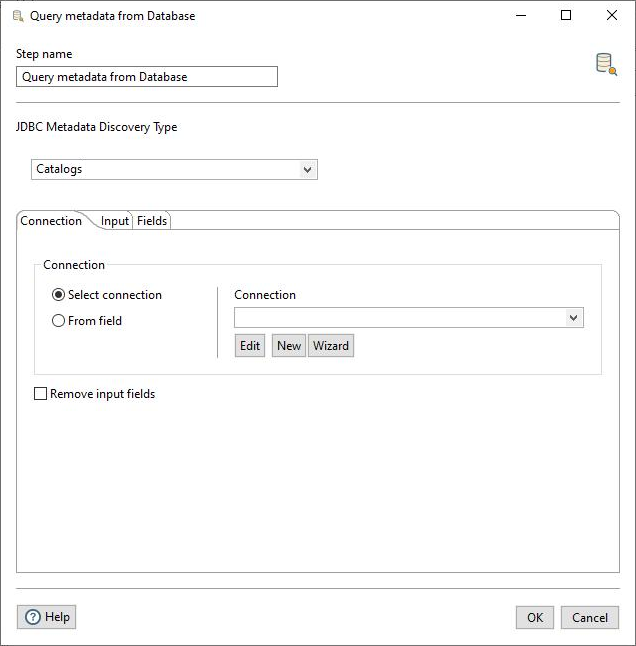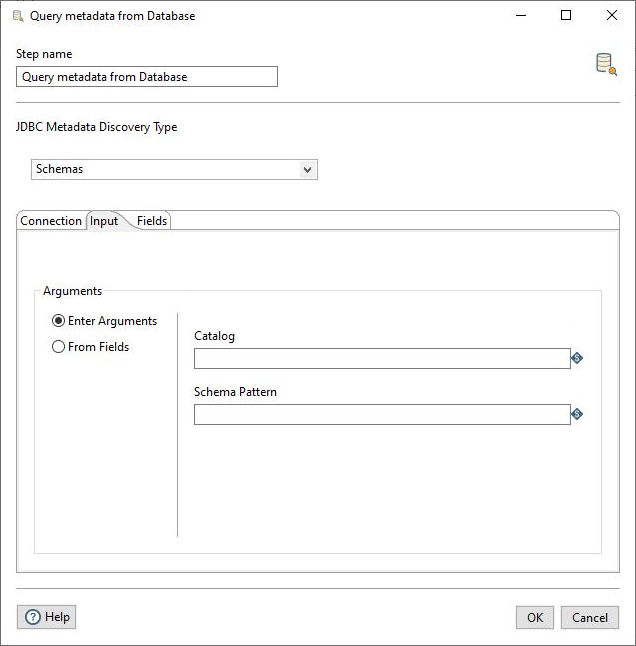Query metadata from a database
You can use the Query metadata from a database step to retrieve metadata from six different JDBC metadata discovery types. This is most useful with metadata injection.
| JDBC Metadata Discovery Types | Description |
| Catalog | Gets a list of catalogs from the database servers. For databases that do not support catalogs, this step type will output no rows. |
| Schemas | Gets a list of schemas from the database servers. For databases that do not support schemas, this step type will output no rows. |
| Tables | Gets a list of tables from the database. |
| Columns | Gets a list of columns from the database. |
| Primary keys | Gets a list of primary keys from the database. |
| Foreign keys | Gets a list of foreign keys from the database. |
General
Enter the following information in the transformation step fields:
Step name: Specify the unique name of the Query metadata from Database step on the canvas. You can customize the name or leave it as the default.
Options
The Query metadata from Database step features three options using the Connection, Input, and Fields tabs. Each tab is described below.
Connection tab

You use the Connection tab to connect to a JDBC database. You have two options when selecting a connection in the Query metadata from Database step.
| Option | Description |
| Select connection | Select a Connection from the dropdown menu. You can use the following options to perform additional actions:
|
| From field | Select a Connection from a display of available fields in the datastream. |
| Remove input fields |
In the From field option, click Remove input fields to omit the fields from prior steps in the transformation data stream. |
Input tab

You use the Input tab to filter the results using specific values for each argument presented in the tab. There are two options.
| Option | Description |
| Enter Arguments | Enter a value for a specific argument. |
| From Fields | Select any fields that are currently available in the transformation stream. |
You use this option to add values to an argument to use to filter the results. See the following table for the argument options for each JDBC Metadata Discovery Type.
| Discovery type | Argument options | Description |
| Catalog | No options | N/A |
| Schemas | Catalog | Specify the name of the catalog to limit the results. If left empty, all schemas from all catalogs are returned. |
| Schema Pattern | Specify a pattern to limit the schemas to return. If empty, the tables from all schemas are returned. % matches 0 or more characters and _ matches exactly 1 character. | |
| Tables | Catalog | Specify the name of the catalog to limit the results. If left empty, all schemas from all catalogs are returned. |
| Schema Pattern | Specify a pattern to limit the schemas to return. If empty, the tables from all schemas are returned. % matches 0 or more characters and _ matches exactly 1 character. | |
| Table Pattern | A pattern limiting the tables to return. If empty, all tables are returned. % matches 0 or more characters and _ matches exactly 1 character. | |
| Table Types | Specify a comma delimited list of table types to limit the results. | |
| Columns | Catalog | Specify the name of the catalog to limit the results. If left empty, all columns from all catalogs are returned. |
| Schema Pattern | Specify a pattern to limit the schemas to return. If empty, the columns from all schemas are returned. % matches 0 or more characters and _ matches exactly 1 character. | |
| Table Pattern | Specify a pattern to limit the columns returned. This usually follows the database's LIKE syntax, but may vary depending on the JDBC driver used. | |
| Column Pattern | Specify a pattern to limit the columns to return. If empty, all tables are returned. % matches 0 or more characters and _ matches exactly 1 character. | |
| Primary Keys | Catalog | Specify the name of the catalog to limit the results. If left empty, all schemas from all catalogs are returned. |
| Schema | Specify the name of the schema to limit the results. | |
| Table | Specify the name of the table to limit the results. | |
| Foreign Keys | Catalog | Specify the name of the catalog to limit the results. If left empty, all schemas from all catalogs are returned. |
| Schema | Specify the name of the schema to limit the results | |
| Table | Specify the name of the table to limit the results. |
You use this option to specify fields within the transformation stream to filter the results. Select a value in one or more of the dropdown menus.
Fields tab

You use the Fields tab to display all the fields within the JDBC discovery type. Click the Get fields button to display all the fields associated with each discovery type in the Field name column.
Optional: Use the Rename to column to rename the field names. The new names will be available in any downstream transformation step.
| JDBC Metadata Discovery Type | Field name | Description |
| Catalog | catalog |
Name of the database catalog |
| Schemas | catalog |
Name of the database catalog |
schema |
Name of the database schema | |
| Tables | catalog |
Name of the database catalog |
schema |
Name of the database schema | |
ref_generation |
Reference generation | |
remarks |
Remarks | |
self_referencing_column_name |
A column that refers to another column in the same table |
|
table_name |
Name of the database table | |
table_type |
Type of the database table | |
type_catalog |
Type catalog | |
type_name |
Type name | |
type_schema |
Type schema | |
| Columns | buffer_length |
Length of the buffer for specific data types |
char_octet_length |
Maximum length, in bytes, for binary data, character data, or text and image data. | |
column_default |
Default value of the column | |
column_name |
Name of the column | |
column_size |
Number of characters or digits of the data | |
data_type |
Data type of the column | |
decimal_digits |
Number of digits after the decimal point | |
is_autoincrement |
Whether the column implements automatic increments | |
is_generated_column |
Whether the column is generated | |
is_nullable |
Whether the column allows null values. | |
nullable |
Column is nullable | |
number_precision_radix |
The base sytsem used for numeric precision (usually base 2 or 10) | |
ordinal_position |
The location of the column ordering within a table or query output | |
pentaho_data_type |
Maps to the custom Pentaho data type | |
pentaho_data_type_int |
Maps to the custom Pentaho integer data type | |
remarks |
Remarks | |
schema |
Name of the database schema | |
scope_catalog |
Catalog that lies within a scope | |
scope_schema |
Schema that lies within a scope | |
scope_table |
Table that lies within a scope. | |
source_data_type |
Data type within a source | |
sql_data_type |
SQL data type for a column | |
sql_datetime_sub |
SQL date/time sub | |
table_name |
Name of a table in the database | |
type_name |
Name of a type in a database | |
| Primary Keys | catalog |
Name of the database catalog |
column_name |
Name of the column | |
key_sequence |
Sequence of the primary key | |
pk_name |
Name of the primary key | |
schema |
Name of the database schema | |
table_name |
Name of a table in the database | |
| Foreign Keys | deferrability |
Whether the primary key have deferred constraints |
delete_rule |
Delete rule for primary key | |
fk_column_name |
Name of the foreign key column | |
fk_name |
Name of the foreign key | |
fk_table_schema |
Schema in the foreign key table | |
key_sequence |
Sequence of the foreign key | |
pk_column_name |
Name of the column in the primary key | |
pk_name |
Name of the primary key | |
pk_table_catalog |
Name of the catalog to which the primary key's table belongs | |
pk_table_name |
Name of the table in the primary key | |
pk_table_schema |
Schema in the primary key table | |
update_rule |
Update rule for primary key |
Metadata injection support
All fields of this step support metadata injection. You can use this step with ETL metadata injection to pass metadata to your transformation at runtime.
